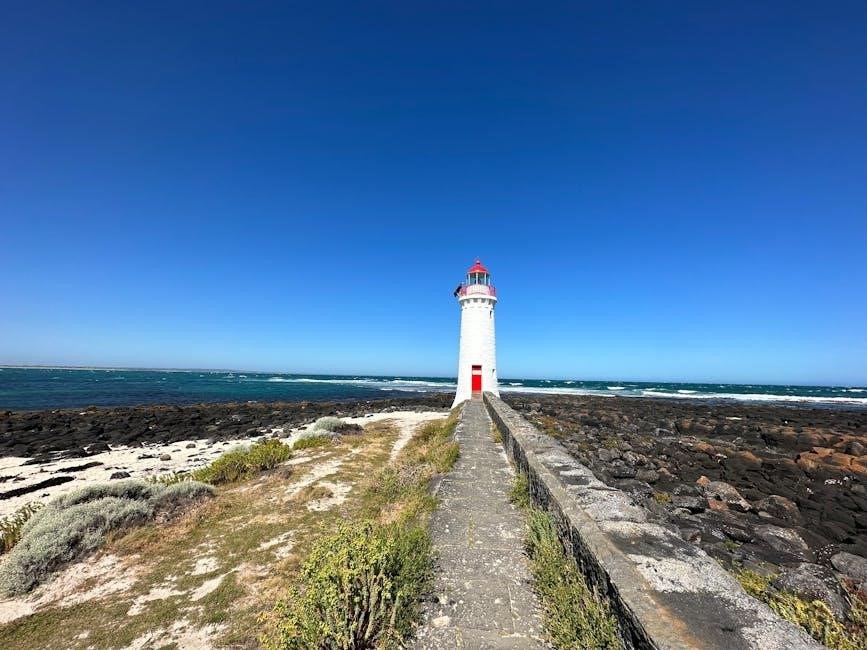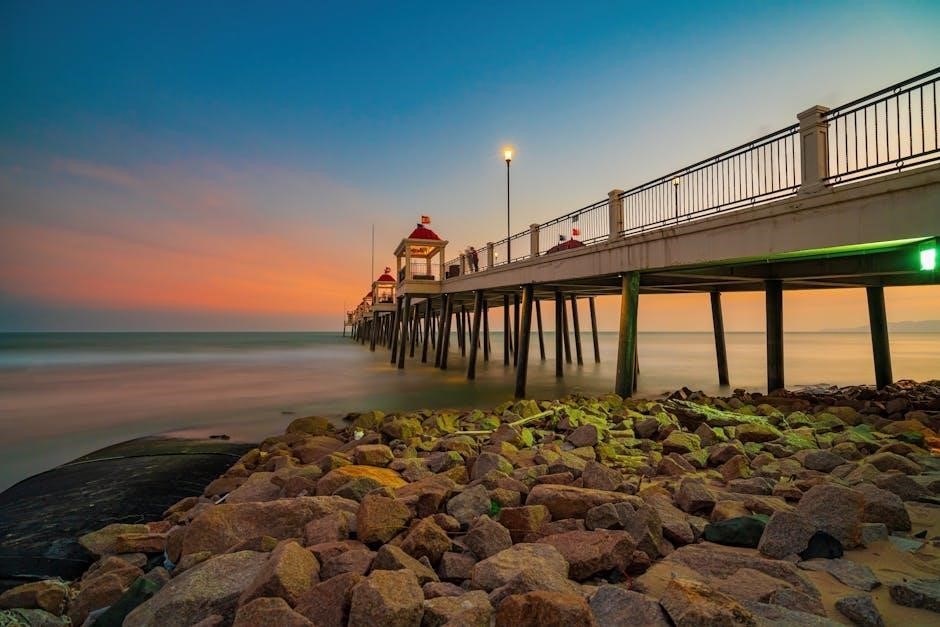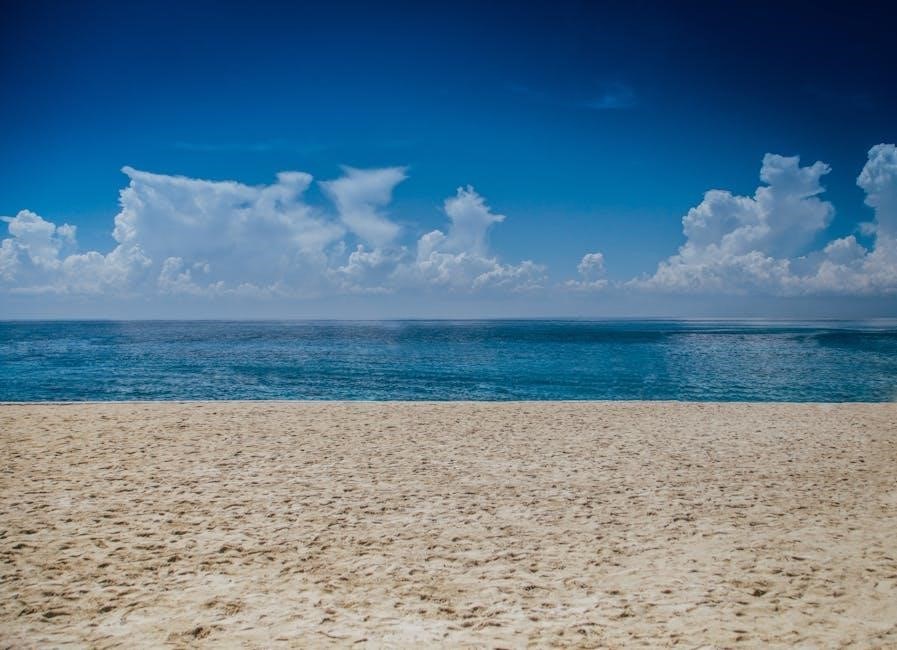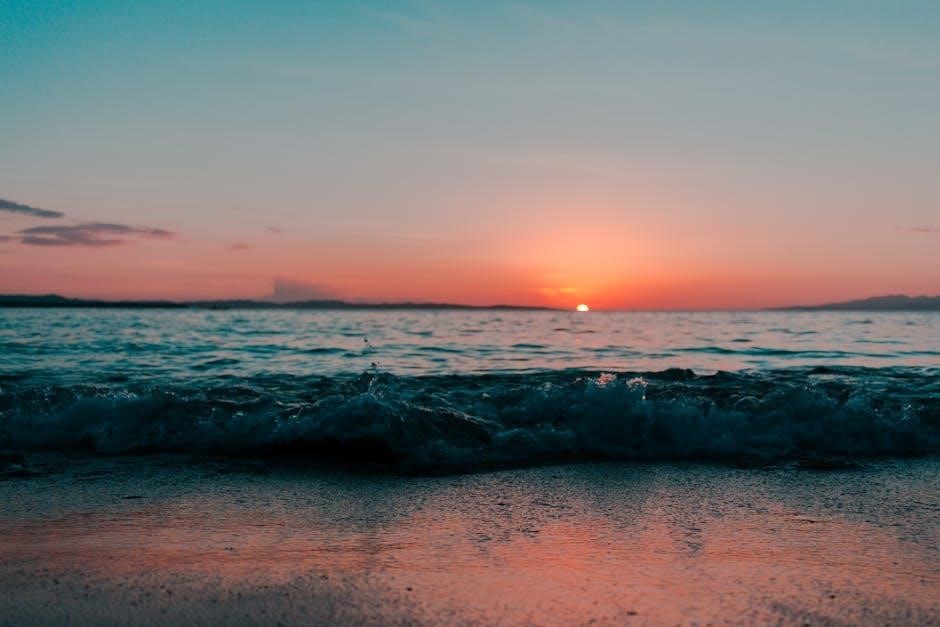Surfing is a captivating water sport that combines physical skill, mental focus, and a deep connection with nature. It offers a unique way to explore coastal environments while challenging oneself physically and mentally. Surfing fosters a sense of community among enthusiasts, creating lifelong friendships and shared experiences. Whether you’re a beginner or an experienced rider, surfing provides endless opportunities for growth, adventure, and personal fulfillment.
1.1 What is Surfing?
Surfing is the exhilarating sport of riding ocean waves using a surfboard. It requires balance, strength, and coordination to glide across the water. Surfers paddle to catch waves, then stand or lie on their boards to ride the swell. This activity combines physical challenge with a deep connection to nature, making it both a sport and a lifestyle for enthusiasts worldwide.
1.2 Why Surfing is Popular
Surfing gains popularity due to its unique blend of adventure, fitness, and mental relaxation. It connects enthusiasts with nature, fostering a sense of freedom and joy. The sport’s global community is welcoming, creating lasting friendships and shared experiences. Its versatility appeals to all skill levels, making it accessible and rewarding for everyone from beginners to seasoned riders, ensuring its enduring appeal worldwide.

Choosing the Right Surfing Equipment
Selecting the proper surfing gear is crucial for performance and safety. Surfboards vary in size and shape for different skill levels, while wetsuits and accessories ensure comfort and protection.
2.1 Surfboards: Types and Sizes
Surfboards come in various shapes, sizes, and materials, catering to different skill levels and surfing styles. Longboards, known for stability, are ideal for beginners, while shortboards offer maneuverability for advanced riders. Funboards and softboards provide versatility and safety, making them popular choices. The right size and type of surfboard ensure better performance and enjoyment in the water.
2.2 Wetsuits and Rash Guards
Wetsuits and rash guards are essential for comfort and protection while surfing. Wetsuits are made from neoprene, providing insulation in cold water and protecting against abrasions. Rash guards offer UV protection and prevent chafing, ideal for warmer conditions. Both come in various thicknesses and styles, ensuring a snug fit. Choosing the right wetsuit or rash guard enhances performance and prolongs time in the water.
2.3 Essential Accessories (Leash, Wax, Fins)
A leash keeps your surfboard attached to your ankle, preventing loss in the water. Wax provides traction on the board, ensuring better grip for your feet. Fins enhance stability and maneuverability, with different sizes and shapes suiting various surfing styles. These accessories are crucial for performance, safety, and control, making them must-haves for every surfer.

Understanding Surfing Basics
Mastering surfing begins with understanding wave dynamics, balance, and timing. Paddling, popping up, and stance are fundamental skills. Practice and patience are key to progression.
3.1 How Waves Form and Behave
Waves are formed by wind friction on the ocean surface, transferring energy to water molecules. As wind duration and fetch increase, waves grow in size and strength. Swell waves travel vast distances, while wind waves form locally. Wave behavior varies with ocean depth and bottom contours, influencing speed and shape. Understanding wave types, from gentle rollers to powerful reef breaks, is essential for surfers to anticipate and ride them effectively.
3.2 Surfing Etiquette and Rules
Surfing etiquette ensures harmony in the water, emphasizing respect and safety. Always yield to the surfer closest to the wave’s peak, as they have the right of way. Avoid dropping in on others and never paddle through a lineup. Be mindful of your position and communicate clearly. Respect local surfers and traditions, as localism can be strong in certain areas. Maintaining a positive and courteous attitude fosters a welcoming environment for everyone.
Surfing Safety Tips
Always assess your abilities against wave conditions, check equipment before entering the water, and stay aware of your surroundings to ensure a safe surfing experience.
4.1 General Safety Precautions
Always check the surf forecast and understand your skill level before entering the water. Warm up to prevent injuries and stay hydrated. Be aware of rip currents and know how to escape them by swimming parallel to the shore. Never surf alone and always follow local advice. Stay alert for changing weather conditions and marine life. Respect the ocean and other surfers to ensure a safe and enjoyable experience for everyone.
4.2 Navigating Dangers (Riptides, Marine Life)
Identify rip currents by discolored or choppy water and escape by swimming parallel to shore. Avoid marine life by wearing protective gear and staying calm. If stung, rinse with vinegar and seek medical help if needed. Stay alert for sharp reefs or rocks and never touch coral reefs. Always check local conditions and warnings before entering the water to ensure a safe surfing experience.
Popular Surfing Destinations
Bali, Hawaii, and Costa Rica are renowned for their consistent waves and stunning beaches, attracting surfers worldwide. These destinations offer ideal conditions for both beginners and pros.
5.1 Best Surf Spots for Beginners
Siargao in the Philippines and Baleal in Portugal are ideal for beginners, offering consistent waves and sandy bottoms. These spots provide safe and forgiving conditions for learning. Bali’s Kuta Beach and Costa Rica’s Tamarindo are also popular, with warm waters and gentle swells. These destinations are perfect for mastering the basics, ensuring a smooth progression in your surfing journey.
5.2 Hidden Gems for Experienced Surfers
Experienced surfers seeking adventure often gravitate toward lesser-known spots like Nihiwatu in Indonesia, known for its world-class waves. Other hidden gems include remote breaks in Mexico and Papua New Guinea, offering challenging swells and untouched beauty. These destinations provide the perfect setting for skilled riders to test their abilities while enjoying pristine, uncrowded conditions. Respect for local etiquette is key to preserving these surf havens.
Advanced Surfing Techniques
Mastering advanced techniques like cutbacks and floaters requires precision and practice. Surfers refine their skills by reading waves and timing maneuvers to ride with style and control.
6.1 Reading Waves and Timing
Reading waves and timing is crucial for advanced surfing. Experienced surfers analyze wave formation, swell direction, and speed to anticipate the best moment to paddle and stand. Timing is everything; being too early or late can mean missing the wave. Practicing wave observation and understanding wave behavior enhances a surfer’s ability to predict and catch waves effectively.
6.2 Advanced Maneuvers (Cutbacks, Floaters)
Advanced maneuvers like cutbacks and floaters are essential for experienced surfers seeking to elevate their skills. A cutback involves turning sharply back toward the wave’s shoulder, allowing riders to stay in the powerful part of the wave. Floaters are tricks performed over whitewater sections, showcasing style and control. Mastering these techniques requires precise timing, balance, and practice, enhancing a surfer’s ability to dominate the wave with finesse.
Localism in surfing often leads to tight-knit communities where residents fiercely protect their breaks. Building relationships with locals requires respect, patience, and understanding of unwritten rules and hierarchies. Localism in surfing refers to the protective attitudes of locals toward their home breaks, often resulting in exclusivity and tension with outsiders. This phenomenon stems from a desire to preserve wave quality and maintain community identity. In some regions, local surfers form groups, like the infamous “White Shorts” in Bali, to enforce unwritten rules and hierarchies in the lineup. Respecting these norms is crucial for harmonious coexistence in the surf community. Building relationships with local surfers begins with respect and humility. Arrive with a positive attitude, smile, and be willing to listen and learn. Familiarize yourself with local surf etiquette and introduce yourself genuinely. Showing interest in their culture and traditions fosters mutual respect. By being polite and considerate, you can earn their trust and build lasting friendships, contributing to a welcoming and inclusive surf community. Environmental awareness is crucial for preserving beaches and oceans. Surfers must adopt sustainable practices, reduce plastic use, and protect marine life to ensure clean, thriving ecosystems for future generations. Protecting beaches and oceans is essential for preserving the surfing environment. Surfers should reduce plastic use, dispose of waste properly, and avoid polluting chemicals. Marine life conservation is vital, as coral reefs and species depend on clean waters. By adopting sustainable practices, surfers can help maintain healthy ecosystems and ensure beautiful coastlines for future generations to enjoy and appreciate. Sustainable surfing practices involve using eco-friendly materials, such as recycled surfboards and biodegradable waxes, to minimize environmental impact. Surfers should support sustainable surf schools and businesses that prioritize ocean conservation. By reducing plastic use, carpooling to surf spots, and participating in beach cleanups, surfers can help protect marine ecosystems; Community-driven initiatives and education are key to promoting environmentally responsible surfing for future generations. Surfing camps and schools offer hands-on training, expert instructors, and a supportive environment for all skill levels. They provide a great way to learn and improve surfing skills while fostering camaraderie and confidence. Many camps are located in stunning coastal locations, making them ideal for immersive surfing experiences. Surf camps provide an immersive experience, offering expert instruction tailored to all skill levels. Participants gain confidence, improve technique, and build strength in a supportive environment. Camps often include equipment rentals, safety tips, and insights into surf etiquette. They also foster camaraderie among attendees, creating lasting connections. Whether you’re a beginner or intermediate, surf camps offer a structured yet fun way to enhance your surfing skills and enjoy the ocean. When choosing a surf school, prioritize certified instructors and a safe learning environment. Look for schools with positive reviews and experienced staff. Consider group sizes to ensure personalized attention. Many schools offer packages with equipment rentals, accommodations, and meal plans. Ensure the curriculum aligns with your skill level, whether you’re a beginner or advancing your skills. Research local options thoroughly to find the best fit for your needs.
Localism and Surfing Communities
7.1 Understanding Localism in Surf Culture
7.2 Building Relationships with Local Surfers

Environmental Awareness
8.1 Protecting Beaches and Oceans
8.2 Sustainable Surfing Practices
Surfing Camps and Schools
9.1 Benefits of Surf Camps
9.2 Finding the Right Surf School
